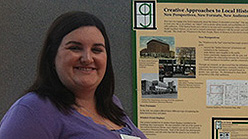
MUSEUM STUDIES
Connecting with the Community

When you move into a new town for graduate school, you know the time there will be short and you wonder if you will really get to know the town. However, the time that you have there depends on what you do while in the community. Over the past two years, I had the chance to work on a project that not only allowed me to look at the history of Greensboro, but also let me talk to members in the community and hear their stories. Windows to the Past: People, Places, and Memory in Downtown Greensboro began as a class project for my introductory Museum Studies seminar in fall 2010. Over the course of four months, each student focused on uncovering the stories behind one building. I researched the history of the S. H. Kress building on Elm Street and developed relationships with people connected to the history. Suddenly, this was more than a brick structure. It was a home and office for an immigrant family from Germany; it was a site of protests during the 1960 sit-ins; and then, it sat silent for many years until Bruce Cantrell and John Lomax purchased and renovated the building.
In December 2011, the class presented the project to the public and the response was phenomenal. We heard more stories than we could imagine and really were able to converse with members of our adoptive community. As a class we decided to expand the project after hearing community members talk about other buildings and ask about how they could view it after our one-night event. In the spring semester, our class received a grant from the North Carolina Humanities Council to expand the original project.
An important part of the fall 2011 Windows to the Past project was community involvement. We went to First Friday festivals downtown each month to talk to people about the buildings they wanted to learn more about and the stories that they had to share. Over the semester, I met a number of community members and learned about a more personal Greensboro history—a history that cannot be learned through books but only through interacting with the community. Research and oral interviews combined to create an exhibit that included sixteen panels throughout downtown, a walking tour brochure, and a website that had information on thirty-six different buildings ( http://mainstreet.lib.unc.edu/projects/greensboro/).
This project allowed me to not only be in Greensboro for school, but really allowed me to interact and get to know the community that I was temporarily a part of. I enjoyed talking to people throughout the semester. At the project’s unveiling in December 2011, visitors not only engaged with the stories we showed them, but also shared their own personal memories downtown. In the end, the message was less about the buildings and more about what downtown meant to different generations. This project reaffirmed how important it is to work with the public to share and create a collective history, and left me with a deeper connection to the Greensboro community that I will have long after graduation.